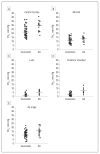Racial differences in ocular oxidative metabolism: implications for ocular disease
- PMID: 21746975
- PMCID: PMC5562541
- DOI: 10.1001/archophthalmol.2011.169
Racial differences in ocular oxidative metabolism: implications for ocular disease
Abstract
Objective: To compare the Po(2) distribution in different regions in the eyes of patients undergoing intraocular surgery.
Methods: Before initiation of intraocular cataract and/or glaucoma surgery, an optical oxygen sensor was introduced into the anterior chamber via a peripheral corneal paracentesis. The tip of the flexible fiberoptic probe was positioned by the surgeon for 3 measurements in all patients: (1) near the central corneal endothelium, (2) in the mid-anterior chamber, and (3) in the anterior chamber angle. In patients scheduled to undergo cataract extraction, Po(2) was also measured (4) at the anterior lens surface and (5) in the posterior chamber just behind the iris. Oxygen measurements at the 5 locations were compared using a 2-tailed unpaired t test and multivariate regression.
Results: The Po(2) value was significantly higher in African American patients at all 5 locations compared with Caucasian patients. Adjusting for age increased the significance of this association. Adjusting for race revealed that age was associated with increased Po(2) beneath the central cornea.
Conclusions: Racial differences in oxygen levels in the human eye reflect an important difference in oxidative metabolism in the cornea and lens and may reflect differences in systemic physiologic function. Increased oxygen or oxygen metabolites may increase oxidative stress, cell damage, intraocular pressure, and the risk of developing glaucoma. Oxygen use by the cornea decreases with age.
Figures



Similar articles
-
Central corneal thickness correlates with oxygen levels in the human anterior chamber angle.Am J Ophthalmol. 2015 Mar;159(3):457-62.e1. doi: 10.1016/j.ajo.2014.11.026. Epub 2014 Nov 26. Am J Ophthalmol. 2015. PMID: 25461296 Free PMC article.
-
Impact of Corneal Endothelial Dysfunctions on Intraocular Oxygen Levels in Human Eyes.Invest Ophthalmol Vis Sci. 2015 Oct;56(11):6483-8. doi: 10.1167/iovs.15-17191. Invest Ophthalmol Vis Sci. 2015. PMID: 26447982 Free PMC article.
-
Oxygen distribution in the human eye: relevance to the etiology of open-angle glaucoma after vitrectomy.Invest Ophthalmol Vis Sci. 2010 Nov;51(11):5731-8. doi: 10.1167/iovs.10-5666. Epub 2010 Aug 18. Invest Ophthalmol Vis Sci. 2010. PMID: 20720218 Free PMC article.
-
Anterior segment imaging and the intraocular pressure lowering effect of cataract surgery for open and narrow angle glaucoma.Semin Ophthalmol. 2012 Sep-Nov;27(5-6):149-54. doi: 10.3109/08820538.2012.708810. Semin Ophthalmol. 2012. PMID: 23163269 Review.
-
Preserve the (intraocular) environment: the importance of maintaining normal oxygen gradients in the eye.Jpn J Ophthalmol. 2014 May;58(3):225-31. doi: 10.1007/s10384-014-0318-4. Epub 2014 Apr 2. Jpn J Ophthalmol. 2014. PMID: 24687817 Review.
Cited by
-
Intraocular Oxygen and Antioxidant Status: New Insights on the Effect of Vitrectomy and Glaucoma Pathogenesis.Am J Ophthalmol. 2019 Jul;203:12-25. doi: 10.1016/j.ajo.2019.02.008. Epub 2019 Feb 15. Am J Ophthalmol. 2019. PMID: 30772349 Free PMC article.
-
Central corneal thickness correlates with oxygen levels in the human anterior chamber angle.Am J Ophthalmol. 2015 Mar;159(3):457-62.e1. doi: 10.1016/j.ajo.2014.11.026. Epub 2014 Nov 26. Am J Ophthalmol. 2015. PMID: 25461296 Free PMC article.
-
Influence of posterior vitreous detachment and type of intraocular lens on lipid peroxidation in the human vitreous.Mol Vis. 2015 Sep 20;21:1106-12. eCollection 2015. Mol Vis. 2015. PMID: 26396488 Free PMC article.
-
Factors determining barrier properties to oxygen transport across model and cell plasma membranes based on EPR spin-label oximetry.Appl Magn Reson. 2021 Oct;52(10):1237-1260. doi: 10.1007/s00723-021-01412-4. Epub 2021 Aug 18. Appl Magn Reson. 2021. PMID: 36267674 Free PMC article.
-
Impact of Corneal Endothelial Dysfunctions on Intraocular Oxygen Levels in Human Eyes.Invest Ophthalmol Vis Sci. 2015 Oct;56(11):6483-8. doi: 10.1167/iovs.15-17191. Invest Ophthalmol Vis Sci. 2015. PMID: 26447982 Free PMC article.
References
-
- Tielsch JM, Sommer A, Katz J, Royall RM, Quigley HA, Javitt J. Racial variations in the prevalence of primary open-angle glaucoma: the Baltimore Eye Survey. JAMA. 1991;266(3):369–374. - PubMed
-
- Javitt JC, McBean AM, Nicholson GA, Babish JD, Warren JL, Krakauer H. Undertreatment of glaucoma among black Americans. N Engl J Med. 1991;325(20):1418–1422. - PubMed
-
- Muñoz B, West SK, Rubin GS, et al. Causes of blindness and visual impairment in a population of older Americans: the Salisbury Eye Evaluation Study. Arch Ophthalmol. 2000;118(6):819–825. - PubMed
Publication types
MeSH terms
Substances
Grants and funding
LinkOut - more resources
Full Text Sources
Other Literature Sources

